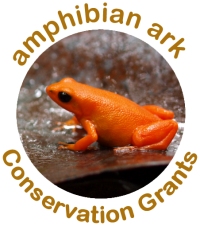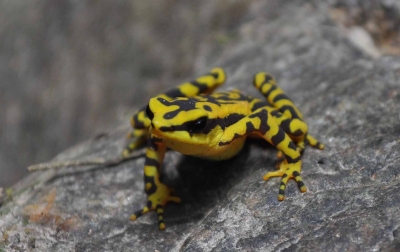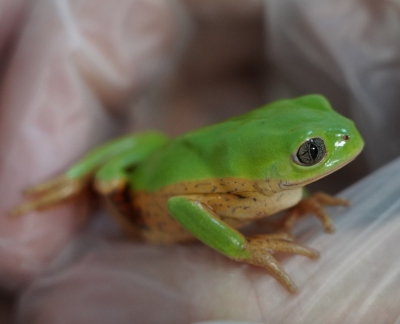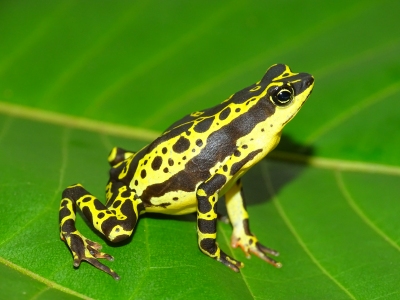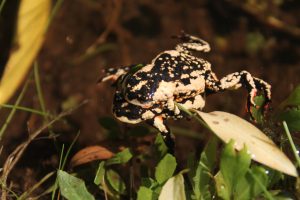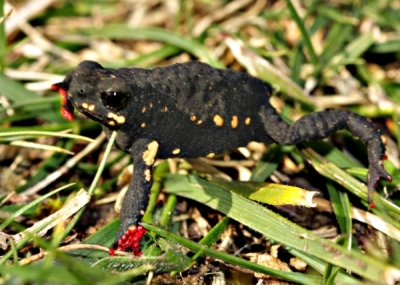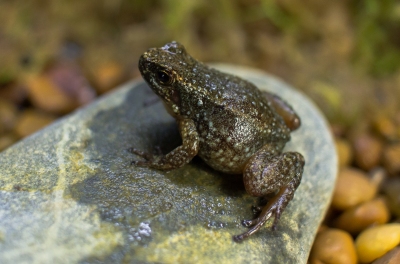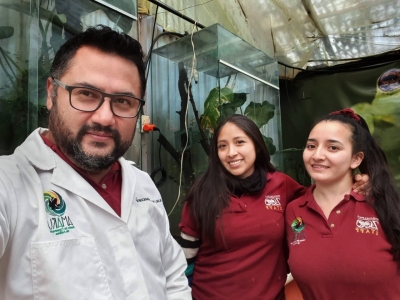Amphibian Ark Conservation Grant winners 2022
AArk has offered grants since 2009, and in the past twelve years, we have provided funding totaling almost US$228,000 to forty-nine projects in twenty-two countries. We are excited to announce our 2022 conservation grant winners – three start-up projects (US$5,000 each, based in Brazil and Venezuela); two start-up extension grants ($4,000 and $3,470, based in Argentina and Venezuela); and one mentorship grant ($1,500, based in Ecuador).
Details of all of our grants, including guidelines and deadlines for lodging applications, can be found on the Conservation Grants page.
AArk is grateful to the following individuals and organizations for their support of our Conservation Grants: Anne Baker and Robert Lacy, Bernard and Nancy Karwick, Ronna Erickson, Woodland Park Zoo
The successful projects this year are:
Startup Grants
- Ex situ rescue of the Rancho Grande Harlequin Frog (Atelopus cruciger) in Venezuela
Margarita Lampo, Fundación para el Desarrollo de las Ciencias Físicas (FUDECI), Venezuela
- Establishment of insurance population for Pithecopus rusticus
Benjamin Phalan, Parque das Aves, Brazil
- Establishing captive breeding and husbandry protocols for Atelopus hoogmoedi, an analog species of the threatened Manauense harlequin toad (A. manauensis) in Brazil
Cybele Lisboa, Reserva Paulista – São Paulo Zoo, Brazil - First ex situ management actions for the conservation of Ceratophrys ornata in Argentina
Sofía M. Perrone – Conservación de Anfibios en Argentina (COANA) - Conservation of Melanophryniscus estebani: An endemic, poorly known species from Chaco Serrano (Argentina)
Startup Extension Grants
- Towards the conservation of the Darwin’s blackish toad (Melanophryniscus nigricans)
Igor Berkunsky, CONICET, Argentina
- Continuing captive breeding efforts for La Culata frog (Aromobates duranti) and the Mucuchíes frog (A. zippeli)
Enrique La Marca, Rescue of Endangered Venezuelan Amphibians (REVA) Conservation Center, Venezuela
Mentorship Grant
- Centro de Conservación de Anfibios Amaru and Detroit Zoo Mentorship Grant
Fausto Siavichay, Centro de Conservación de Anfibios Amaru (CCA-Amaru), Ecuador
Here are the executive summaries from each of the successful applicants.
Ex situ rescue of the Rancho Grande Harlequin Frog (Atelopus cruciger) in Venezuela
Margarita Lampo, Fundación para el Desarrollo de las Ciencias Físicas (FUDECI), Venezuela
The Rancho Grande harlequin frog (Atelopus cruciger) is the only harlequin toad with known viable populations in Venezuela. Although it disappeared in the late 1980s, presumably due to chytridiomycosis, this species was rediscovered in 2003. Only two nearby subpopulations have been detected, despite continuing efforts to find these toads in their former habitats.
A. cruciger is currently listed as Critically Endangered in the IUCN Redlist and recommended for ex situ rescue. Relict populations have maintained few hundred mature individuals for almost one decade, despite the presence of chytrid fungus. Chytrid transmission is low and juvenile recruitment sufficiently high to compensate for losses due Bd-induced mortality. This means that scenarios that increase Bd transmission rates could rapidly push these populations to a collapse, and possibly the species to extinction, if backup captive colonies are not available.
Our goal is to establish an ex situ facility for A. cruciger at the Leslie Pantin Paya Zoo, as a stopgap measure for an integrated long-term conservation plan that includes its reintroduction into former habitats in lowland habitats (i.e. thermal refuges). During a pilot study with very limited resources, we were able to obtain one egg batch, but low tadpole survival and high incidence of spindly leg syndrome due to calcium deficiency resulted in a low success in metamorphosis. Nonetheless, we have demonstrated that A. cruciger can breed in captivity.
With the start-up grant, we expect to obtain F1 juveniles. Funds will be applied to the acquisition of equipment for establishing one large reproduction unit and twenty small maintenance tanks. Required permits have already been obtained and proposals to obtain further funds for scaling up have been submitted to the UK Embassy in Caracas and the Price Bernard Nature Fund.
Establishment of insurance population for Pithecopus rusticus
Benjamin Phalan, Parque das Aves, Brazil
Pithecopus rusticus was described in 2014 and is a Brazilian endemic, restricted to a single site, with a maximum number of thirty-four individuals observed. It has not yet been evaluated on the global Red List, but at the national level in Brazil it is evaluated as Critically Endangered. The species is vulnerable to a range of threats including drainage, pesticide pollution, alteration of habitat by cattle, and possibly climate change and drought. Extensive searches for the species in other apparently suitable sites in the region have not located any additional populations. Individuals have been recorded with Batrachochytrium dendrobatidis (chytrid fungus).
The need for an ex situ population was identified in a Conservation Needs Assessment in 2020. This insurance population was started with the capture of two adult individuals in early 2022 and these were transported to Parque das Aves, in collaboration with Instituto Claravis, São Paulo Zoo, ICMBio and the Federal University of Santa Maria.
The purpose of this proposal is to construct additional facilities that will enable the expansion of this ex situ population into a functional insurance population, which serves as a backup in case of the possible extinction of the species in the wild, and to keep options open for future reintroduction or population reinforcement. This is the first amphibian species maintained at Parque das Aves, but we are fortunate to have the close support of São Paulo Zoo, an institution with extensive experience with amphibian husbandry.
Establishing captive breeding and husbandry protocols for Atelopus hoogmoedi, an analog species of the threatened Manauense harlequin toad (A. manauensis) in Brazil
Cybele Lisboa, Reserva Paulista – São Paulo Zoo, Brazil
The Manauense harlequin toad (Atelopus manauensis) is a recently named species with a very small geographic range in the vicinity of Manaus, the largest city in the Brazilian Amazon. It has few remnant populations under strong pressure from the fast and irreversible deforestation for urban and agriculture expansion. For these reasons, it will be listed as globally Endangered in the updated IUCN Red List of Threatened Species (J. Lüedtke, pers. comm.).
To manage the threats, the species was included in the Harlequin Toad (Atelopus) Conservation Action Plan, created collectively by the Atelopus Survival Initiative (ASI), a massive collaborative effort to conserve harlequin toads. One of the strategies included in the plan is the establishment of captive breeding programs for Atelopus species and maintenance of backup populations for future supplementation in the wild. In the Conservation Needs Assessment conducted in 2020, Ex Situ Rescue was recommended as a conservation action for A. manauensis, since identified threats cannot be reversed in time to prevent its extinction.
In the current project, we intend to take the first step before creating a backup population of A. manauensis. As this species has never been maintained in captivity, we aim to establish husbandry and breeding protocols using an analog and widespread species, the Hoogmoed harlequin toad (A. hoogmoedi, Least Concern) that occupy habitats similar to A. manauensis. We will collect five paris of A. hoogmoedi and bring them to the Reserva Paulista – São Paulo Zoo. Protocols will be tested and established based on the previous experience of the Project Leader and her team with Scinax alcatraz, Nyctimantis pomba and other Brazilian amphibians.
First ex situ management actions for the conservation of Ceratophrys ornata in Argentina
Sofía M. Perrone – Conservación de Anfibios en Argentina (COANA)
The Argentine horned frog (Ceratophrys ornata) is an amphibian which is endemic to the temperate grasslands of Argentina, Brazil and Uruguay. The last records for Brazil and Uruguay date back to 1982 and an intense field search conducted by our working group since 2018 would confirm that the species is extinct in both countries. In Argentina, the conservation status is Vulnerable, while the Conservation Needs Assessment (2021) highlights the possibility of initiating ex situ management accompanied by research and education activities. In 2017, our working group identified priority areas for the conservation of Ceratophrys ornata in Argentina in which we conducted studies of population dynamics, reproductive phenology and habitat requirements in parallel with a communication strategy to link communities and key actors. The main threats facing the species in these areas are the increasing urbanization that brings with it a profound modification of the wetland systems where Ceratophrys ornata reproduces, and the elimination of individuals by aversion. Additionally, we have identified and mapped areas feasible to be included in a planning of ex situ management actions that allow increased survival of the species and ensure the viability of the populations.
The main objective of this project is to implement an Ex Situ Management Plan in relict populations of Ceratophrys ornata. This plan will include the rescue and translocation of adult specimens from urbanized areas to sites identified with habitats conducive to the species. In addition, eggs and larvae from fragmented wetlands will be collected, which will be raised to juvenile stages in a reception center for the subsequent release of nearby populations. In the long term and in synergy with in situ activities, we hope to reduce the impact of habitat loss on relict populations of Ceratophrys ornata.
Conservation of Melanophryniscus estebani: an endemic, poorly known species from Chaco Serrano, Argentina
Dr. Nadia Carla Bach, National University of San Luis, Argentina
Central Pampean Sierras (Argentina) host endemic amphibians associated with grasslands and high altitude forests stand out (1600-2100 msnm). Melanophryniscus estebani, which does not have a common name, is a microendemic anuran categorized as Data Deficient (DD) by IUCN and has been recommended as species for rescue by Amphibian Ark. Threats in their microhabitat involve exotic species introduction, urbanization, grassland fires and mining practices releasing contaminants. Researchers suggest that, considering the current status of populations, it’s necessary to monitor and promote conservation programs to understand unknown biology aspects of the species. In framework of Argentina Amphibian Conservation Plan, this project for M. estebani conservation aims to develop ex-situ management techniques, preserve the species in captivity, develop an Action Plan for the long term conservation, study aspects of M. estebani biology currently unknown, establish normal parameters of health to in-situ studies, and monitoring the actual status of the populations in the wild. Expected results are to collect founder pairs, achieve ex-situ reproduction, know aspects of M. estebani reproductive biology, estimate parameters in captivity related to physiological stress indicators, know the conservation status of M. estebani in San Luis and implement an Action Plan for the species conservation.
Towards the conservation of the Darwin’s blackish toad (Melanophryniscus nigricans)
Igor Berkunsky, CONICET, Argentina
Darwin’s blackish toad (Melanophryniscus nigricans) is a threatened, recently described species. Since 1970, the wild populations of this species have dramatically declined by more than 70%. At least two well-known populations have become extinct, and a third is probably extinct. The remnant populations face a combination of threats: habitat loss by forestry, invasive woody species, and quarries; overgrazing and trampling by livestock; chytrid fungus; and desiccation caused by climate change.
In 2017, we started a conservation initiative to identify the main threats and explore practical conservation actions to recover the population of Darwin’s blackish toad. Currently, only one protected area (the Sierra del Tigre Natural Reserve) effectively guards a wild population of this toad. With the reserve managers, we initiated a habitat restoration project to provide more habitat for Darwin’s blackish toad. However, natural recolonization by Darwin’s blackish toad is unlikely due to current fragmentation and the lack of corridors between highland grassland remnants.
In 2019, and thanks to a start-up grant from the Amphibian Ark, we conditioned an ex situ facility at the university campus and established a survival colony. During the last two breeding seasons (2020-2021 and 2021-2022), we successfully conducted headstarting of eggs by collecting clutches from wild breeding sites and maintaining them in captivity until they become juveniles. All individuals produced in captivity were translocated to restored and protected habitats in the Sierra del Tigre Natural Reserve. This project achieves the first effective conservation tool for Darwin’s blackish toad, connecting the current populations, and increasing the viability of the species.
With this extension grant, we hope to achieve the following outcomes:
- Have an Action Plan for Darwin’s blackish toad signed by participants, including the managers of Sierra del Tigre Natural Reserve, which is the legal manager of main area for the species.
- Improve the ex situ facility on the campus of the University, and an increase in the production of individuals for translocation.
- Create the third sanctuary for Darwin’s blackish toad.
- A translocation strategy included in the Species Action Plan is promoted to start in 2022.
Continuing captive breeding efforts for La Culata frog (Aromobates duranti) and the Mucuchíes frog (A. zippeli)
Enrique La Marca, Rescue of Endangered Venezuelan Amphibians (REVA) Conservation Center, Venezuela
Conservation of endangered amphibian species is a must for the Venezuelan Andes, the most biodiverse region in the country. REVA continues, as an amphibian conservation center, to devote efforts to rescue some of the most threatened frog taxa in the country. Since its inception in the year 2018, and thanks to the support of Amphibian Ark, REVA managed to raise and breed several high Andean frogs that are in risk of extinction.
The first most successful programs at Rescue of Endangered Venezuelan Amphibians (REVA) were those with the Merida collared frog (Mannophryne collaris) and the Merida whistling frog (Leptodactylus meridensis), both with reintroduction programs that ended up in well established and monitored populations in the Merida terrace. These species, along with the recently described banana frog (Boana platanera La Marca et al., 2021 in Zootaxa) established well and reproduced successfully in the temperate room at REVA, with conditions closely resembling the ones prevalent in their regions of origin. All other amphibian species kept at REVA in Mérida city, most belonging to the genera Dendropsophus, Pristimantis and Aromobates, have been raised in the Center’s cold room, assisted with air conditioners. The resulting colder conditions are more favorable for cloud forest and paramo species.
After successfully managing captive breeding and reintroduction programs for the Merida collared frog and the Merida whistling frog, as well as the banana frog established well and reproducing successfully in the temperate room at REVA, we are applying for an extension grant to continue the captive breeding efforts with two species’ programs that received financial support from AArk since their start, namely, the La Culata Frog (Aromobates duranti) and the Mucuchíes frog (A. zippeli). The proposal is also addressed to rescue additional specimens of these endangered amphibians through captive husbandry and breeding, as well as to plan and execute later releases and monitoring of their offspring in the wild.
Following we sum up the intended goals with the requested extension grant:
- To establish new ex situ conservation programs for La Culata Frog and the Mucuchíes frog in a new ex situ facility under more natural conditions, starting with new parental stocks collected from the wild.
- To set a up an artificial enclosure for the Mucuchíes frog in the Moconoque region, to keep specimens under controlled natural conditions, taking advantage that there is a natural water spring and a short slow-moving stream.
- To introduce or re-introduce captive born-and-raised offspring of both species into previously studied suitable places within their respective ranges of distribution.
- To continue the program of involvement of the local community at the places of origin of both species, and to spread knowledge and concern on the species and the need to protect the habitats they occupy.
Centro de Conservación de Anfibios Amaru and Detroit Zoo Mentorship Grant
Fausto Siavichay, Centro de Conservación de Anfibios Amaru (CCA-Amaru), Ecuador, and Blake Klocke, Detroit Zoo, USA
The Conservation Center for Amphibians – Amaru (CCA-Amaru) and Detroit Zoological Society (DZS, USA) have been involved with mitigating the current amphibian biodiversity crisis through ex situ conservation for many years. The AArk Mentorship grant will provide an opportunity to form international collaboration to strengthen both institutions in achieving their amphibian conservation goals. Fausto Siavichay has been involved with ex situ amphibian conservation, research, education, and outreach in Ecuador since 2007. Blake Klocke, from DZS has worked with ex situ populations of endangered Panamanian amphibians (primarily Atelopus species) since 2013, mitigation research, and has led three reintroduction trials of captive bred Atelopus from the Panama Amphibian Rescue and Conservation Project.
CCA-Amaru was established in 2008 to mitigate amphibian declines due to emerging diseases, habitat fragmentation, and urbanization. Collaboration between CCA-Amaru and DZS will focus on Atelopus husbandry, captive breeding, and developing reintroduction strategies and methodologies. CCA-Amaru and DZS have combined captive husbandry knowledge of ten Atelopus species. Developing strategies, providing guidance, and sharing lessons learned from Atelopus spp. reintroduction trials will provide information important for future planning. The amphibian species at CCA-Amaru include Atelopus bomolochos (CR), Atelopus exiguous (EN), Atelopus nanay (CR), Atelopus sp. ‘Wampukrum’ (Not Evaluated), Atelopus balios (CR), Pristimantis erythros (Not Evaluated), Hyloxalus vertebralis (CR), Cenophryne aequatorialis (LC), and Gastrotheca cuenca (Not Evaluated).
Funding from this mentorship grant will support DZS staff to make a one-week trip to CCA-Amaru in 2022. DZS will match the grant amount to allow an additional member to join the trip (Blake Klocke and a member from the animal care staff team). Fausto and Blake will work together to develop an itinerary before the trip for efficient time usage during the visit to CCA-Amaru. This mentorship exchange will help both institutions in their efforts to conserve the most imperiled genus of amphibians and strengthen international ex situ amphibian conservation efforts.



